
- •Unit I Compressors
- •Compressors
- •Types of Compressors
- •The Axial-Flow Compressors
- •Unit II The Centrifugal-Flow Compressors
- •The Centrifugal-Flow Compressor
- •Operating limits
- •Unit III Compressor Stall
- •Compressor Stall
- •Unit IV Operation of the Combustion Chamber
- •Operation of the Combustion Chamber
- •Combustion chamber ge j79
- •Inlet Ducts
- •I. In the text, find definitions of :
- •Inlet Ducts
- •Unit VI
- •Unit VII Turbines
- •Unit VIII
- •Unit IX Supersonic Ducts
- •Supersonic Ducts
- •Unit X Noise Supression Problem
- •Sound Suppression. The Noise Problem
- •С.А. Авдейко, г.В. Любаева Развитие профессиональных компетенций студентов технических вуЗов: учебное пособие по развитию навыков перевода технической литературы (на английском языке)
- •443086, Самара, Московское шоссе, 34.
- •443086, Самара, Московское шоссе, 34.
Федеральное агентство по образованию
Государственное образовательное учреждение
высшего профессионального образования
"Самарский государственный аэрокосмический университет имени академика С.П. Королева"
С.А. Авдейко, Г.В. Любаева
Развитие профессиональных
компетенций студентов
технических ВУЗов
учебное пособие по развитию навыков перевода технической литературы
(на английском языке)
Утверждено Редакционно-издательским советом университета в качестве учебного пособия
Самара Издательство СГАУ 2010
УДК
ББК
Рецензент канд. пед. наук, доц. каф. ин. яз. О. Н. М а р т ы н о в а
С.А. Авдейко, Г.В. Любаева
Развитие профессиональных компетенций студентов технических ВУЗов: учебное пособие по развитию навыков перевода технической литературы (на английском языке): учеб. пособие по английскому языку / С.А. Авдейко, Г.В. Любаева. – Самара: Изд-во Самар. гос. аэрокосм. ун-та, 2010. – 83 с.: ил.
.
Данное учебное пособие предназначено для студентов технических ВУЗов факультета «Двигателестроение». Чётко структурированная система заданий обеспечивает поэтапную отработку материала и гармонично развивает навыки перевода технической литературы. Упражнения пособия имеют также коммуникативную направленность, что помогает студентам развивать устную речь по технической тематике.
Самарский государственный
аэрокосмический университет, 2010

Unit I Compressors
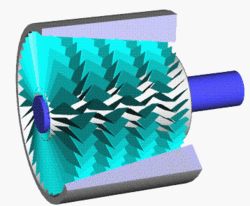
Before you begin
I. Have you ever met the term “Compressor” in technical literature? Can you suggest a definition? What sphere of application do you think it may concern?
II. Brainstorm all possible terms related to the topic.

Reading
I. In the text, find definitions of :
a) -compression efficiency
-axial flow compressor
-centrifugal flow compressor
-centrifugal-axial-flow compressor
-stage
-rotor blades
-stator vanes
b) try to define the meaning of the term “compression ratio” as you understand it.
II. Skim the text and try to explain the meaning of marked words from the content of the text.
III. Read the text and write out the words and word combinations you don’t know, try to guess their meaning from the context. Compare your notes with your partners.
Compressors
T he
role of the compressor in a gas turbine engine is to provide a
maximum of high-pressure air which can be heated in the limited
volume of the combustion chamber and then expanded
through the turbine. The energy that can be released in the
combustion chamber is proportional to the mass of air consumed;
therefore the compressor is one of the most important components of
the gas turbine engine since its efficient operation (maximum
compression with minimum temperature rise) is the key to high overall
engine performance. The compressor efficiency will determine the
power necessary to create the pressure rise of a given airflow and
will affect
the temperature change which can take place in the combustion
chamber. Present-day compressors have compression ratios approaching
15:1, efficiencies near 90 percent, and airflows up to approximately
350 lb/s.(158,8 kg/s).
he
role of the compressor in a gas turbine engine is to provide a
maximum of high-pressure air which can be heated in the limited
volume of the combustion chamber and then expanded
through the turbine. The energy that can be released in the
combustion chamber is proportional to the mass of air consumed;
therefore the compressor is one of the most important components of
the gas turbine engine since its efficient operation (maximum
compression with minimum temperature rise) is the key to high overall
engine performance. The compressor efficiency will determine the
power necessary to create the pressure rise of a given airflow and
will affect
the temperature change which can take place in the combustion
chamber. Present-day compressors have compression ratios approaching
15:1, efficiencies near 90 percent, and airflows up to approximately
350 lb/s.(158,8 kg/s).
With the addition of a fan, total pressure ratios of 25:1 and mass airflows of over 1000 lb/s (453,6 kg/s) have been achieved.
Types of Compressors
All gas turbine engines use one of the following forms of compressors:
1. Axial flow.
2. Centrifugal flow.
The centrifugal-axial-flow compressor is a combination of the two, with operating characteristics of both.
The Axial-Flow Compressors
The axial-flow compressor is made up of a series of rotating airfoils called rotor blades and a stationary set of airfoils called stator vanes. As its name implies, the air is being compressed in a direction parallel to the axis of the engine. A row of rotating and stationary blades is called a stage. The entire compressor is made up of a series of alternating rotor and stator vane stages. Some axial-flow designs have two or more compressors or spools which are driven by separate turbines and are therefore free to rotate at different speeds.
Axial compressors have the advantage of being capable to very high compression ratios with relatively high efficiencies.
In addition, the small frontal area created by this type of compressor lends itself to installation in high-speed aircraft. Unfortunately the delicate blading, especially toward the rear, makes this type of air pump especially susceptible to foreign object damage. Furthermore, the number of compressor blades and stator vanes (which can exceed 1000 in a large jet engine), the close fits required for efficient air pumping, and the much narrower range of possible operating conditions, make this type of compressor very complex and very expensive to manufacture. Modern manufacturing techniques are bringing down the cost for small axial-flow compressors. For these reasons the axial-flow design finds its greatest application where the demands of efficiency and output predominate considerations of cost, simplicity, flexibility of operation, etc. Most manufactures utilize several dodges to increase flexibility and to improve the operating characteristics of the axial-flow compressor.
Post Reading
I. a) Fill in the diagram according to the content of the text.
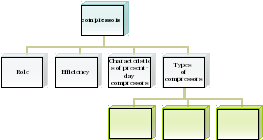
b) Make a diagram for the part of the text where axial-flow compressors are spoken in detail. Share it with your partner and fill it.
II. a) Find the English equivalents to the following words and word combinations in the text:
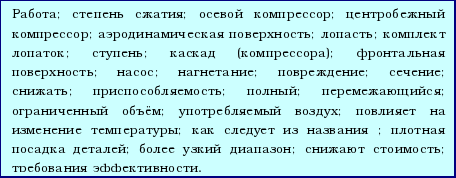
b) Reproduce the context in which they were used.
III. Complete the following sentences using the ideas from the text.
1. The role of the compressor in a gas turbine engine is to provide …
2. The compressor efficiency will determine …
3. The compressor efficiency will affect the temperature …
4. The centrifugal-axial-flow compressor is a …
5. The air in the axial-flow compressor is being compressed in a direction …
6. The entire compressor is made up of …
7. Spools are driven by …
8. Axial compressors have the advantage of …
9. The small frontal area of axial-flow compressor lends itself to …
10. … make axial-flow compressor very complex and very expensive to manufacture.
11. Axial-flow design finds its greatest application …
III. Explain the difference between rotating and stationary blades.
IV. Choose the one sentence that best keeps the content of the text.
V. Translate the following sentences into English and answer them according to the content of the text.
1. Почему компрессор является одним из наиболее важных компонентов газотурбинных двигателей?
2. Что определяет КПД компрессора?
3. Что называется ступенью компрессора?
4. Из чего состоит компрессор?
5. Какими преимуществами и недостатками обладает осевой компрессор?
6. Что делает осевой компрессор сложным и дорогостоящим в изготовлении?
7. Где осевой компрессор находит наибольшее применение?
Language in use
I. Find the Russian equivalents to the words from column a) from the words from column b)
|
a) |
b) |
|
Since |
Влиять |
|
Key |
Приблизительно |
|
Affect |
Весь |
|
Approximately |
Особенно |
|
Addition |
Чередующийся |
|
Entire |
Сравнительно |
|
Alternating |
Конструкция |
|
Design |
Поэтому |
|
Therefore |
Преимущество |
|
Advantage |
К сожалению |
|
Relatively |
Добавление |
|
Unfortunately |
Ключ |
|
Especially |
Поскольку |
|
furthermore |
Более того |
II. Find pairs of synonyms among the words.


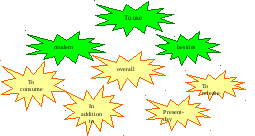
III. Use the prepositions in the box to complete the sentences in the text. Translate the text with the help of a dictionary in written.

Axial-flow compressors are dynamic rotating compressors that use arrays … fan-like airfoils to progressively compress the working fluid. They are used where there is a requirement … a high flows or a compact design. The arrays … airfoils are set … rows, usually as pairs: one rotating and one stationary. The rotating airfoils, also known as blades or rotors, accelerate the fluid. The stationary airfoils, also known as a stators or vanes, turn and decelerate the fluid; preparing and redirecting the flow … the rotor blades … the next stage. Axial compressors are almost always multi-staged, … the cross-sectional area … the gas passage diminishing along the compressor to maintain an optimum axial Mach number. Beyond about 5 stages or a 4:1 design pressure ratio, variable geometry is normally used to improve operation.
IV. Find pairs of antonyms among the words.
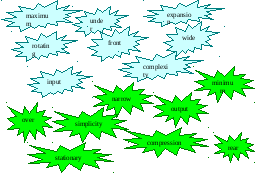
V. Fill in the gaps with the suitable derivative of the word given in brackets, use the suffixes in the oval. Translate the text, define the main idea of it in one phrase.

Axial compressors rely on _______ (to spin) blades that have aerofoil sections, similar to aeroplane wings. As with aeroplane wings in some conditions the blades can stall. If this happens, the airflow around the _______ (to stall) compressor can reverse direction _______ (violent). Each design of a compressor has an _______ (to associate) operating map of airflow versus _______ (to rotate) speed for characteristics peculiar to that type.
At a given throttle condition, the compressor operates somewhere along the steady state running line. Unfortunately, this _______ (to operate) line is displaced during transients. Many compressors are fitted with anti-stall systems in the form of bleed bands or _______ (to vary) geometry stators to decrease the likelihood of surge. Another method is to split the compressor into two or more units, operating on separate concentric shafts.
VI. Match words in A with their definitions in B and use them in your own sentences.
|
A |
B |
|
1. limited |
1. to become larger in size and filling more space |
|
2. to determine |
2. to use a supply of smth such as time, energy, or fuel |
|
3. efficiency |
3. not together |
|
4. to expand |
4. all or every part of smth |
|
5. release |
5. Able to do smth |
|
6. to consume |
6. the process of putting a new system or piece of equipment in its place and making it ready for use |
|
7. set |
7. the ability to make changes or to deal with a situation that is changing |
|
8. separate |
8. to have more power, influence,or importance then other things |
|
9. to rotate |
9. not allowed to go above a particular number, amount, or level |
|
10. entire |
10. smth that can be easily damaged or broken |
|
11. capable |
11. easily influenced or affected by smth |
|
12. installation |
12. the ability to work well and produce good results |
|
13. flexibility |
13. adjustment |
|
14. delicate |
14. making a gas or liquid move into or out of smth |
|
15. fit |
15. to control or to officially decide smth |
|
16. pumping |
16. a dishonest or clever way to avoid doing smth unpleasent |
|
17. to predominate |
17. to move in a circle around a fixed central point |
|
18. susceptible |
18. a group of things |
|
19. dodge |
19. to let smth leave a place where they have been kept |
VII. Translate the following sentences. Pay special attention to the underlined words. Give your own explanation of them.
1. Another design consideration in axial-flow compressor manufacturing is the average stage loading.
2. This can be kept at a sensible level either by increasing the number of compression stages (more weight/cost) or the mean blade speed (more blade/disc stress).
3. Although large flow compressors are usually all-axial, the rear stages on smaller units are too small to be robust.
4. Consequently, these stages are often replaced by a single centrifugal unit.
5. Very small flow compressors often employ two centrifugal compressors, connected in series.
6. Although in isolation centrifugal compressors are capable of running at quite high pressure ratios (e.g. 10:1), impeller stress considerations limit the pressure ratio that can be employed in high overall pressure ratio engine cycles.
Speaking
Here is the diagram illustrated the main types of gas compressors. Choose one of the types and make a short report for your group mates could compare the performances and sphere of their application.
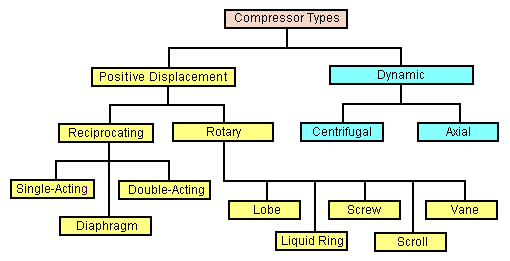
Writing
Summarize the information given in the text “Compressors”. Use the key-patterns.

